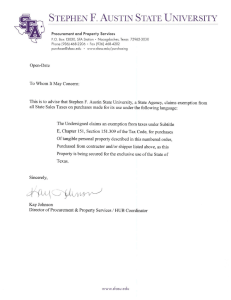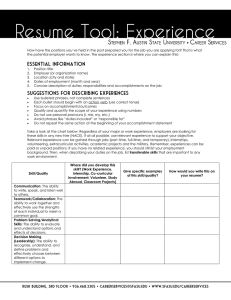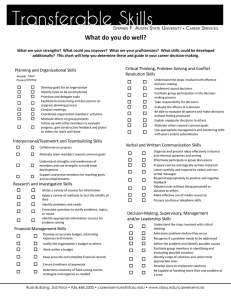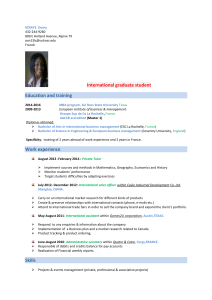Document 10400407
advertisement
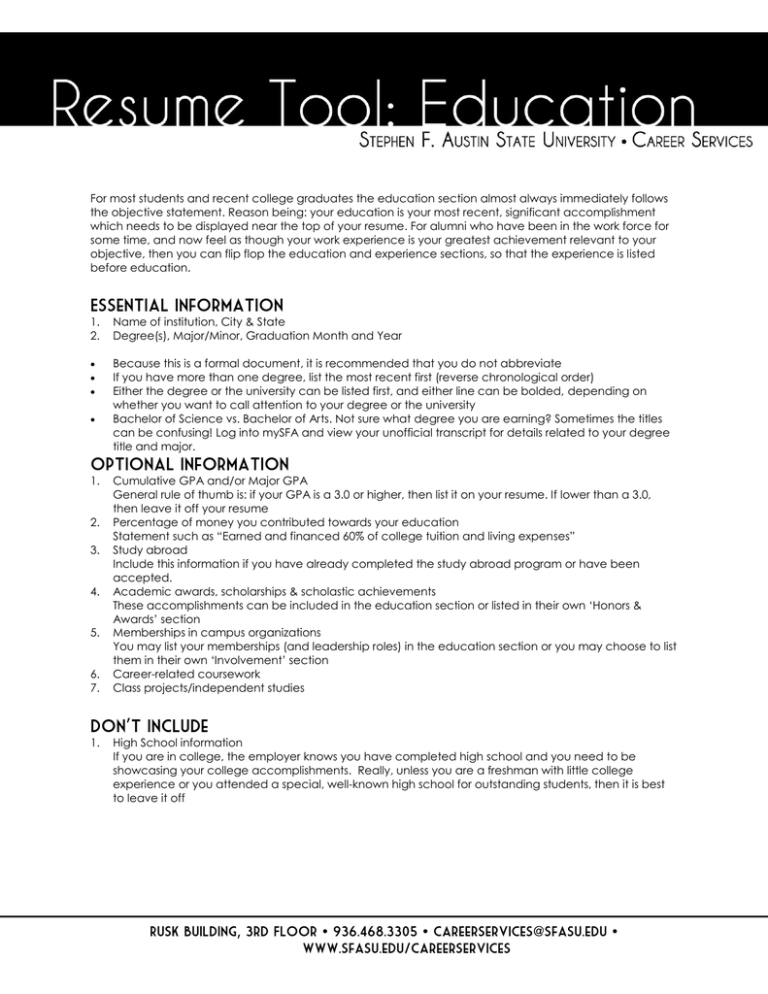
For most students and recent college graduates the education section almost always immediately follows the objective statement. Reason being: your education is your most recent, significant accomplishment which needs to be displayed near the top of your resume. For alumni who have been in the work force for some time, and now feel as though your work experience is your greatest achievement relevant to your objective, then you can flip flop the education and experience sections, so that the experience is listed before education. Essential Information 1. 2. Name of institution, City & State Degree(s), Major/Minor, Graduation Month and Year Because this is a formal document, it is recommended that you do not abbreviate If you have more than one degree, list the most recent first (reverse chronological order) Either the degree or the university can be listed first, and either line can be bolded, depending on whether you want to call attention to your degree or the university Bachelor of Science vs. Bachelor of Arts. Not sure what degree you are earning? Sometimes the titles can be confusing! Log into mySFA and view your unofficial transcript for details related to your degree title and major. Optional Information 1. 2. 3. 4. 5. 6. 7. Cumulative GPA and/or Major GPA General rule of thumb is: if your GPA is a 3.0 or higher, then list it on your resume. If lower than a 3.0, then leave it off your resume Percentage of money you contributed towards your education Statement such as “Earned and financed 60% of college tuition and living expenses” Study abroad Include this information if you have already completed the study abroad program or have been accepted. Academic awards, scholarships & scholastic achievements These accomplishments can be included in the education section or listed in their own ‘Honors & Awards’ section Memberships in campus organizations You may list your memberships (and leadership roles) in the education section or you may choose to list them in their own ‘Involvement’ section Career-related coursework Class projects/independent studies Don’t Include 1. High School information If you are in college, the employer knows you have completed high school and you need to be showcasing your college accomplishments. Really, unless you are a freshman with little college experience or you attended a special, well-known high school for outstanding students, then it is best to leave it off Rusk Building, 3rd Floor 936.468.3305 careerservices@sfasu.edu www.sfasu.edu/careerservices Examples One degree: Stephen F. Austin State University, Nacogdoches, Texas Bachelor of Science in Kinesiology, May 2020 Minor: Secondary Education Cumulative GPA: 3.2 Two degrees from same institution: Stephen F. Austin State University, Nacogdoches, Texas Master of Arts in Rehabilitation Counseling, May 2020 Bachelor of Arts in Psychology, December 2016 Two degrees from different institutions: Stephen F. Austin State University, Nacogdoches, Texas Bachelor of Science in Nursing, May 2017 Cumulative GPA: 3.78; Magna Cum Laude President’s Honor Roll: 4 semesters; Dean’s List: 4 semesters Angelina College, Lufkin, Texas Associate of Science, December 2008 Transferring credits: Stephen F. Austin State University, Nacogdoches, Texas Bachelor of Business Administration, December 2017 Major GPA: 3.4 Tarrant County College, Fort Worth, Texas Coursework completed towards undergraduate degree Rusk Building, 3rd Floor 936.468.3305 careerservices@sfasu.edu www.sfasu.edu/careerservices
